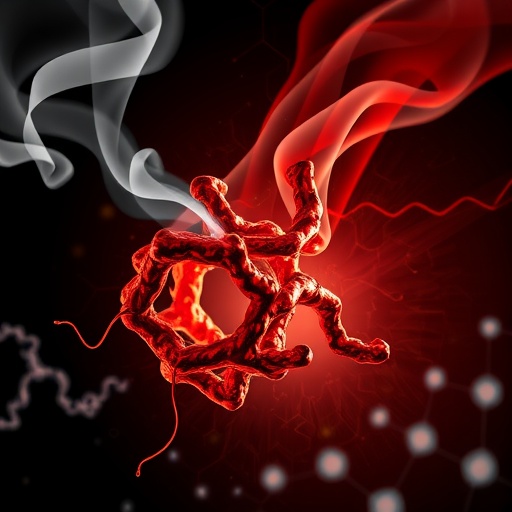
Credit: World Scientific
The rapidly growing field of astrochemistry focuses on the chemistry occurring in stars, planets, and the interstellar medium, bringing together elements of chemistry, physics, astrophysics, and biology. Much of the history of the universe, the formation of chemical elements, stars and planets, and the development of the complex chemistry occurring on planet Earth, can be explained through application of basic principles of physical chemistry. Astrochemistry: from the Big Bang to the present day provides an account of our planet's place within the Universe from the perspective of a physical chemist.
Authored by Prof Claire Vallance, Professor of Physical Chemistry at the University of Oxford, the book tells the story of the development of chemistry within the universe–starting at the beginning with the Big Bang, and progressing through the spontaneous formation of the first chemical elements, and later, the formation of higher chemical elements through stellar nucleosynthesis in three generations of stars. Attention then shifts to the rich variety of 'alien' chemistry occurring in large interstellar gas clouds, with a tour through the chemical mechanisms we know of to date, some of the outstanding problems still to be solved, and a detailed consideration of the variety of theoretical and experimental laboratory-based techniques that can provide insight into molecules in space. The formation of the solar system and planet Earth is explored, with explanations of the formation of the moon and the historical development of its orbit about Earth, the layered structure of the Earth, the Earth's magnetic field, plate tectonics, geochemistry, oceans and tides, and the development of the atmosphere. The book finishes with an overview of the search for extra-Solar planets and the likelihood of life existing in other regions of the Universe.
b>Astrochemistry: from the Big Bang to the present day provides an ideal opportunity to bring together many different aspects of physical chemistry and demonstrate their relevance to the world we live in. Astronomy has long been the domain of physicists, but scientists working within the rapidly growing field of astrochemistry are currently making great strides in revealing the chemical history of the Universe, and this book also aims to serve this very purpose- to highlight the importance and pertinence of the chemical aspects in astronomy.
While there is plenty to interest the general reader, this book is aimed at intermediate to advanced undergraduates of chemistry and astrochemistry. Said Prof Vallance, "This book has its origins in a public engagement lecture I was persuaded to give during the UK's national Science Week several years ago, entitled "What in the World? A Chemical History of the Earth". The talk grew first into a short third-year option course for undergraduate chemists at the University of Oxford, until finally morphing, following some persuasion, into a book. I hope that readers will enjoy reading and learning about the fascinating field of astrochemistry as much as I have enjoyed writing about it."
This book retails for US$45 / £37 in paperback, and US$98 / £81 in hardback at major bookstores. To know more about the book visit http://www.worldscientific.com/worldscibooks/10.1142/q0011.
###
About the Author
Claire Vallance is a Professor of Physical Chemistry in the Department of Chemistry at the University of Oxford, and Tutorial Fellow in Physical Chemistry at Hertford College. She holds B.Sc.(hons) and Ph.D. degrees from the University of Canterbury (Christchurch, NZ), where she worked on gas-phase molecular dynamics. She then moved to Oxford, where she held a Glasstone Research Fellowship and a Royal Society University Research Fellowship prior to her present appointment. Her current research interests include reaction dynamics, applications of velocity-map and spatial-map imaging to mass spectrometry, and the development of laser spectroscopy techniques employing optical microcavities for microfluidics and chemical sensing applications. Claire's Oxford tutorial teaching spans all of physical chemistry. She has given lecture courses on chemical kinetics, properties of gases, symmetry and group theory, reaction dynamics, and astrochemistry, as well as numerous outreach and public engagement lectures. She is author of over 90 journal articles, four book chapters, nine patents, an e-Textbook on Symmetry and Group Theory, and recently co-edited the textbook Tutorials in Molecular Reaction Dynamics.
About World Scientific Publishing Co.
World Scientific Publishing is a leading independent publisher of books and journals for the scholarly, research, professional and educational communities. The company publishes about 600 books annually and about 130 journals in various fields. World Scientific collaborates with prestigious organizations like the Nobel Foundation and US National Academies Press, amongst others, to bring high quality academic and professional content to researchers and academics worldwide. To find out more about World Scientific, please visit http://www.worldscientific.com. For more information, contact Amanda Yun at [email protected]
Media Contact
Amanda Yun
[email protected]
@worldscientific
http://www.worldscientific.com
############
Story Source: Materials provided by Scienmag




